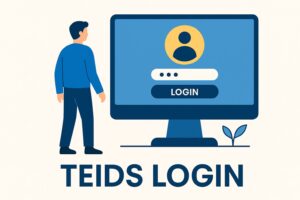When I first learned about the TEIDS system, I figured it was just another government database tucked away online. But the deeper I looked, the more I realized how central it is to Tennessee’s ability to deliver critical early intervention services. The teids login is more than a portal—it’s the secure gateway that allows providers to coordinate care, track child development, and manage records that ultimately shape family support across the state.
For service providers, administrators, and staff, understanding how to use the TEIDS login isn’t just helpful—it’s necessary. In this guide, I’ll walk you through every detail: what TEIDS is, who can access it, how to log in, and what to do if you run into problems. Think of this as your one-stop resource for everything related to TEIDS login.
What is TEIDS login and why is it important?

TEIDS stands for Tennessee Early Intervention Data System, a statewide platform that supports TEIS (Tennessee Early Intervention System). TEIS is responsible for helping infants and toddlers with developmental delays get services that can improve learning and growth during their earliest years.
The login is the front door to that system. It’s how authorized users—such as therapists, administrators, and program managers—access sensitive data about children and families. Without this secure point of entry, it would be impossible to coordinate services effectively or meet state and federal compliance requirements.
In practice, this means:
- Providers can safely document progress.
- Administrators can ensure programs are meeting state guidelines.
- Families benefit from a more consistent, organized approach to care.
The importance of TEIDS login is simple: it keeps vital information safe while making it accessible to the right people at the right time.
Where do you find the official TEIDS login portal?
The only official portal is hosted at teids.org/teids. If you need access, always use this exact link. It’s common for people to try searching “teids login” in a browser, but that sometimes leads to third-party pages that are not secure. Bookmarking the official link is the best way to avoid mistakes.
Because TEIDS handles highly sensitive data, the portal is protected against unauthorized use. This isn’t a system anyone can stumble into—it’s reserved strictly for authorized personnel.
Who can access the TEIDS login system?
Not everyone can access TEIDS. The system is specifically designed for:
- Service providers who work directly with families and children through TEIS.
- Program administrators who oversee local operations and ensure compliance.
- State-level staff who manage data, reporting, and quality assurance.
Parents and families do not receive direct access to TEIDS. Instead, their assigned providers use the system to update records and share progress reports. This division ensures that sensitive personal data remains tightly controlled, while families still benefit from the services coordinated through the platform.
What credentials are required to log in?
Logging in requires a username and password assigned by TEIS administrators. These aren’t credentials you can create on your own—they’re provided only after approval.
Passwords must meet strict complexity requirements to protect against unauthorized access. That means using a mix of uppercase and lowercase letters, numbers, and special characters. You’ll also need to update your password regularly to keep your account secure.
A unique security rule applies: you must log in at least once every 90 days. If you don’t, your account may be disabled. This requirement ensures that inactive accounts don’t remain open indefinitely, reducing the risk of data breaches.
Here’s a summary table for clarity:
| Requirement | Details |
| Username | Assigned by TEIS administrator |
| Password | Must meet complexity rules; updated regularly |
| Password Reset | Required after expiration or lockouts |
| Account Activity | Must log in at least once every 90 days to keep account active |
How do you log in to the TEIDS portal step by step?
The process itself is straightforward, though it comes with best practices worth remembering.
- Visit the official TEIDS login page: teids.org/teids.
- Enter your username and password exactly as assigned. Pay attention to case sensitivity.
- Complete any secondary verification if prompted.
- Click “Login” and wait for your dashboard to load.
Once inside, you’ll have access to the tools you need—whether that’s updating progress data, reviewing reports, or managing case information. If you’re logging in for the first time, you may be required to reset your password immediately.
What should you do if you forgot your TEIDS password?
Everyone forgets a password now and then, but TEIDS has a more controlled process than most systems. There’s no self-service reset button. If you forget your password, you’ll need to reach out directly to your TEIS administrator.
They’ll verify your identity, confirm your authorization, and walk you through creating a new password. It may take a little longer, but this extra layer ensures that unauthorized individuals can’t simply guess their way into the system.
How do you create a new TEIDS account?
Unlike typical apps or services, there’s no “Sign Up” button for TEIDS. All accounts are created through official TEIS channels. If you’re a new provider or staff member, you’ll need to request an account through your supervisor or program lead.
Once approved, the administrator will provide your username and temporary login details. From there, you’ll follow the setup instructions, which typically include setting a permanent password and confirming security requirements.
What common issues occur with TEIDS login?
Even the most secure systems can run into hiccups. TEIDS users often encounter a few recurring issues:
- Invalid credentials: Often caused by typos or outdated passwords.
- Expired passwords: If too much time has passed since your last reset.
- Locked accounts: Triggered by inactivity beyond the 90-day rule.
- Browser problems: Some users find that older browsers don’t play well with the system.
Knowing these common roadblocks makes it easier to troubleshoot quickly when you hit a snag.
How can you troubleshoot TEIDS login errors?
When problems occur, start with the basics. Make sure you’re logging in through the correct portal and that your internet connection is stable. Clearing your browser cache and cookies often solves loading errors.
If you’re still having trouble, try switching browsers or updating to the latest version. Double-check your password for complexity and accuracy. If none of these steps help, your administrator will be the one to reset your access.
What security measures does TEIDS login use?
The system is built with strong security layers that protect sensitive data. Multi-factor authentication is sometimes used to add an additional step beyond the password. Single Sign-On integration helps authorized users streamline access across connected systems. All data is encrypted during transfer, and session timeouts automatically log users out after inactivity.
These features work together to ensure compliance with state and federal data privacy laws. For providers, it means peace of mind knowing that the information they handle is safe.
What are the benefits of using TEIDS login for providers?
For providers, TEIDS login is much more than a password gate. It’s the tool that makes their work manageable and efficient. Through the portal, they can securely record developmental milestones, update progress notes, and share data with administrators. This centralization prevents duplication of effort and makes it easier to coordinate across multiple providers.
It also improves accountability. Administrators can track service delivery, ensure compliance with guidelines, and make data-driven decisions about program improvements. Ultimately, this helps families receive higher-quality services tailored to their child’s needs.
What best practices should you follow for TEIDS login security?
Even though the system itself is secure, users have a role to play. Always create a strong password and update it regularly. Avoid reusing passwords from other systems, and never share your login details with colleagues.
Make it a habit to log out of the system when you’re finished, especially if you’re working on a shared or portable device. These small steps help reduce the risk of unauthorized access.
What is the future of TEIDS login and system updates?
Like all technology, TEIDS continues to evolve. Future updates may focus on streamlining the login experience, integrating new reporting features, or improving compatibility with mobile devices. With growing emphasis on cybersecurity, additional security layers may also be introduced.
For providers, this means fewer login headaches and a smoother, more efficient workflow. For families, it means a stronger system that ensures their information remains safe and services stay consistent.
Also Read : Emergingtechs.net Stay Updated Always
FAQs
What is the official website for TEIDS login?
The only official website is teids.org/teids. Always use this direct link.
Can parents or families access TEIDS login?
No. Only authorized providers and staff within TEIS can use the system. Families rely on providers to manage their child’s records.
How often do I need to log in to keep my TEIDS account active?
You must log in at least once every 90 days. Accounts that remain inactive beyond that period will be disabled.
What should I do if my TEIDS account gets locked?
Contact your TEIS administrator. They will verify your information and reset your account.
Can I create a TEIDS login account myself?
No. All accounts must be requested and approved through TEIS administrators.
Final Thoughts: Why TEIDS Login Matters
On the surface, the teids login looks like any other portal, but it represents far more. It’s the entry point to Tennessee’s entire system for delivering early intervention services. By understanding how it works, following security best practices, and staying active in the system, providers can make sure their access is smooth and reliable.
As TEIDS continues to grow and update, the teids login will remain the cornerstone of how services are coordinated, tracked, and improved. For providers and administrators, it isn’t just a login—it’s a responsibility that directly impacts the lives of children and families across the state.









